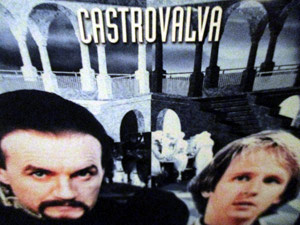Castrovalva
“That’s the trouble with regeneration. You never quite know what you’re going to get.” – The Doctor
 This story is definitely not as good as I once thought it was. Its best element is the idea of Castrovalva folding in on itself and the characters’ growing discovery of that fact—but that comes very late in the story. Most of it is simply Tegan and Nyssa dithering, confusing interactions with Adric, and the Doctor trying to get a nap in. Actually, there are several intended “surprises” in the story, but they are not surprises at all: the Master tells us that he has put the TARDIS crew in a trap and that he has set up another one to follow so we already know that something will be amiss with Castrovalva and the ending idea that Castrovalva was created by him was also already pretty much signaled from the start.
This story is definitely not as good as I once thought it was. Its best element is the idea of Castrovalva folding in on itself and the characters’ growing discovery of that fact—but that comes very late in the story. Most of it is simply Tegan and Nyssa dithering, confusing interactions with Adric, and the Doctor trying to get a nap in. Actually, there are several intended “surprises” in the story, but they are not surprises at all: the Master tells us that he has put the TARDIS crew in a trap and that he has set up another one to follow so we already know that something will be amiss with Castrovalva and the ending idea that Castrovalva was created by him was also already pretty much signaled from the start.
The early aspects of the new Doctor trying to find himself (and Peter Davison getting to play around with impressions of previous Doctors) are kind of nice. I like the concept of the zero room (though I’m not quite sure how its properties transfer to the cabinet?) and the parts where it seems a sentient TARDIS is to helping the Doctor make his way through the corridors is also quite good (and evocative of the elements in the similar Hartnell story of years before). And while it does feel a bit ominous as the lipstick on the walls starts to melt signaling the march towards Event 1, the tension unfortunately dissipates quickly and the whole section of interaction between Tegan and Nyssa lack depth.
The Master’s plan in kidnapping and using Adric doesn’t quite make sense, so when it is all revealed it seems a bit of a let down. (It obviously cannot have been developed in the few minutes that we see the Master leave and reappear on Earth—there must have passed years in between for him). I do have to give acting credit to Anthony Ainley though. As a kid, I definitely didn’t know the Portreeve was the Master. Maybe I would have guessed as a more savvy adult viewer (there is something in Anthony Ainley’s eyes that is hard to hide), but he really does do a great job disguising his voice and stature. There is some nice direction too. One unimportant but quite well done scene is when the camera follows the trail of blood up to the Doctor lying on the ground. It then continues to pan on and we see the trail go past, showing very clearly that it was not he who was bleeding.
The story comes alive mostly at the end when all the run around within Castrovalva starts. I liked it as a kid for all the ideas of “recursive occlusion” and its mirroring of MC Escher. It’s just not as profound as I thought it was and overall it’s a rather boring introduction story.
Best (or worst) unsettling moment:
The story plays off of something being not quite right with Castrovalva. It is first hinted that there may be some malevolence in the Castrovalvan people, but then it slowly become clear that it’s more something off kilter about the whole place itself. This is a good building of tension and probably the best aspect of the story. I especially like the part where the Doctor is made to realize that the ancient volumes of Castrovalvan history actually go up to present day.
Firsts:
- The Fifth Doctor’s celery
- Zero room
Retrofit:
Is the first mention of a perception filter? It’s not actually called that but the Master does mention someone having tampered with a Castrovalvan’s “perception threshold”.
Regrets:
Perhaps the story would have been more engaging with more time on the Castrovalva mystery and less on the Event One rabbit trail. They definitely should have had the scene with the women at the washtub pointing at the same thing in several directions come after they had started to hint at the idea that something was wrong and not before. It would have added to the surreal feeling that way. Putting it at the start makes it seem like they are just a lot of uncooperative people. It also would have been better if the amazing changing tapestry had shown scenes which were literally woven into the fabric—but I guess that would have been beyond the budget of the program.
